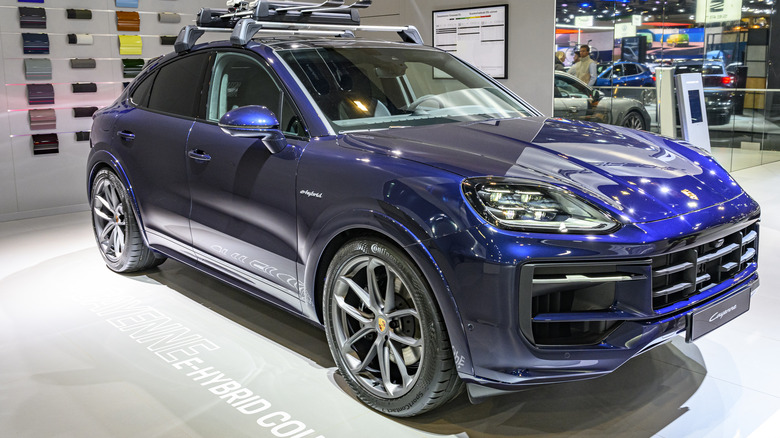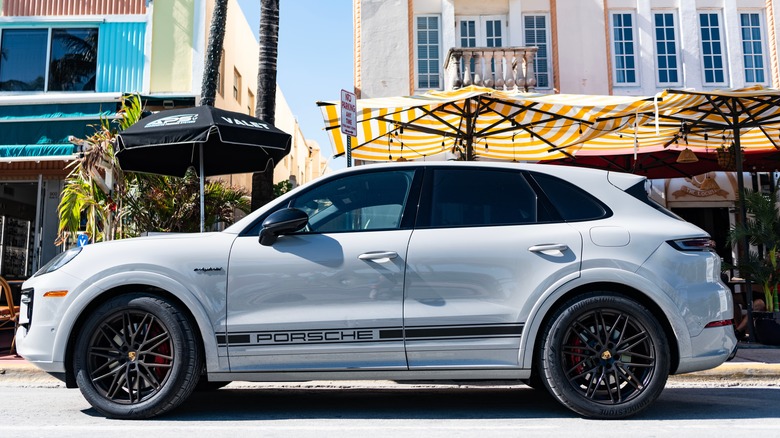Macan Vs. Cayenne: Which Porsche SUV Is Bigger & How Much Do They Cost?
When it debuted for the 2003 model year, the Porsche Cayenne paved a bold, new path for the iconic German automaker. By 2005, this pioneering Porsche SUV accounted for over half of the company's sales in the U.S., topping the legendary 911. Seeking a repeat of this success, Porsche launched the smaller Macan SUV for 2015. This compact utility became the company's best-selling vehicle a year later and hasn't looked back since.
Yet, there are notable differences between these two Porsche SUVs. The Cayenne can be called the Macan's big brother in two ways: it's been in showrooms longer and is larger in just about every dimension. At the same time, Porsche shoppers can expect to pay less for a Macan than a Cayenne, given comparable trims in their respective model ranges.
While both models share Porsche's DNA, each has a different focus. The Macan offers five-door versatility in a more compact package, making it more urban-friendly. It's also the most affordable new Porsche you can buy. Meanwhile, the Cayenne earns flagship SUV status for the brand. It's brawnier, offers more variants (including the sleeker Coupe edition), and costs twice as much as its smaller stablemate.
How size separates the Porsche SUVs
Assessing the base trims, the Macan takes a back seat in overall length at 186.1 inches versus 194.1 inches for the Cayenne. Unsurprisingly, the smaller Porsche is narrower, too: 75.7 inches (with the mirrors folded) compared to 78.1 inches for the Cayenne. Likewise, the Macan doesn't stand as tall, at 63.8 inches against the Cayenne's 66.9 inches. Underpinning these dimensional differences is a 110.5-inch wheelbase for the Macan versus 114.0 inches for the Cayenne.
Cargo space also helps explain the size difference between these two Porsche SUVs. Behind the second row, the Macan offers 17.2 cubic feet, while the Cayenne (non-Coupe) provides 27.3 cubic feet, almost 60% more. However, folding down the back seats shows less separation: 53.1 cubic feet for the Macan and 60.3 cubic feet for the Cayenne — about a 13% difference.
Porsche doesn't publish interior dimensions for the Macan and Cayenne, so there's no precise information available about legroom or headroom. However, the Macan has 96 cubic feet of passenger volume compared to 104 cubic feet for the Cayenne. Based on this, the Cayenne's cabin is about 8.5% larger.
Comparing prices for the Porsche Macan and Porsche Cayenne
With 8 trims for the Macan and 13 for the Cayenne, pricing stretches from five to six figures for both models. Before destination charges, the cheapest 2026 Porsche Macan costs $63,100, while its 2026 Cayenne counterpart will set buyers back $86,800. Pricing goes north from there. The mid-tier Macan S with 375 horsepower and a zero-to-60 mph time of 4.6 seconds has an MSRP of $76,200. On the Cayenne side, the S trim is slightly slower (4.7 seconds), more powerful (468 horsepower), and more expensive ($103,700). A similar price gap exists with each model's GTS variant. For the Macan, spending $91,000 gets you a 434-horsepower GTS that requires 4.3 seconds to reach 60 mph. Conversely, the 493-horsepower Cayenne GTS sells for $127,000.
From there, unique versions of each model come into play. Notably, the Cayenne Coupe variants don't have a Macan equivalent. The base Cayenne Coupe starts at $91,900, with prices crossing into six-figure territory for premium trims like the S ($110,100) and GTS ($131,600). The Coupe-based Turbo GT is the most expensive and powerful Cayenne, with a price starting at $205,900. It can reach 60 mph from a standstill in 3.1 seconds thanks to 650 horsepower. The Cayenne E-Hybrids (including the Coupe versions) cost $98,900 to $163,300.
For the Macan, electrification means an all-electric variant starting at $75,300. The Macan 4 Electric stickers at $78,000, while the 4S Electric costs $84,900. The Turbo Electric is the king of the Macan hill in terms of price and performance. It has an MSRP of $105,300, 630 horsepower, and a zero-to-60 mph time of 3.1 seconds.


